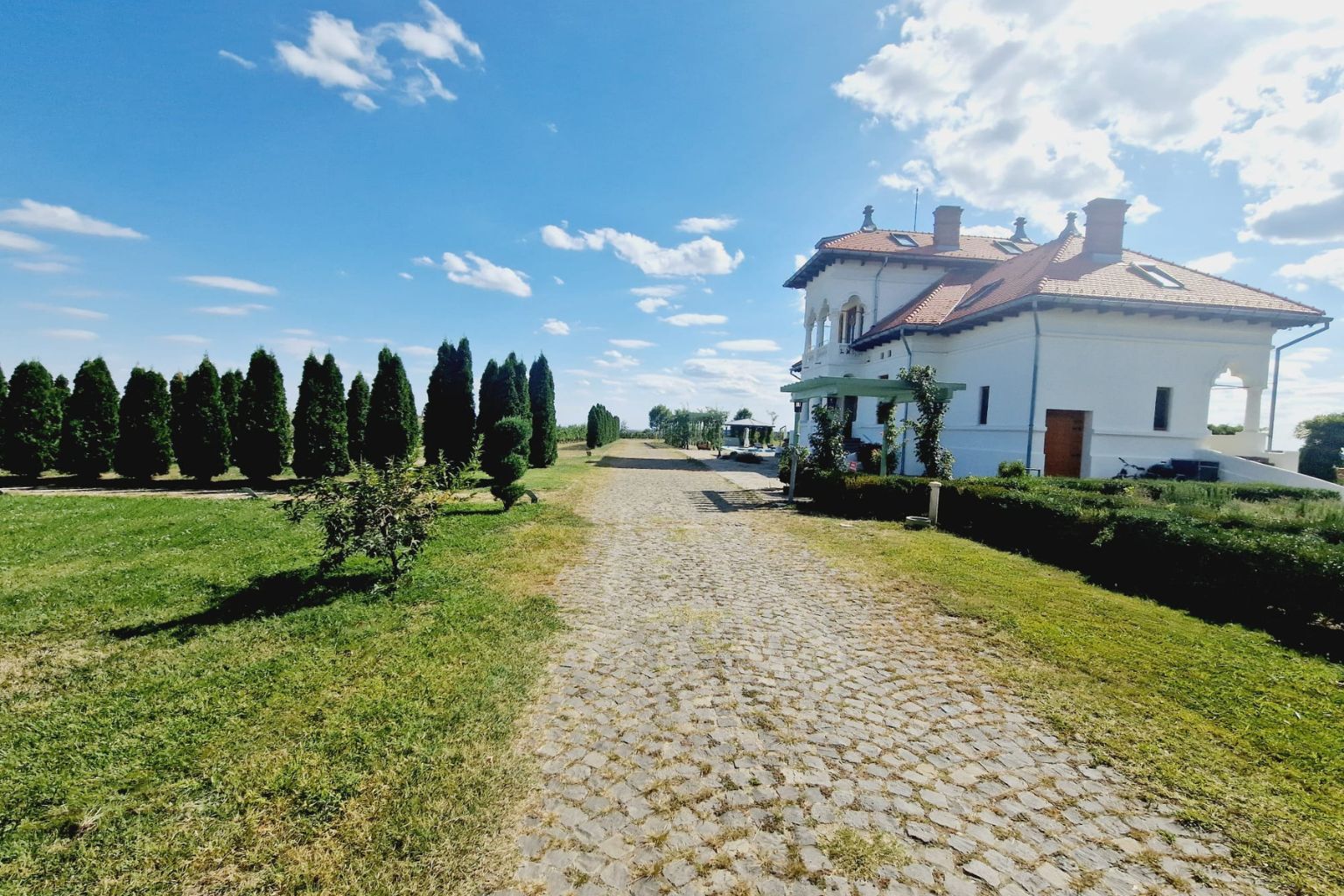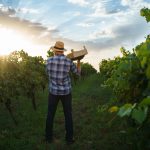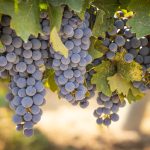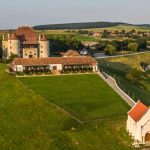This week began with a long-awaited reunion, which the Wines of Romania team managed to fit in, just before heading to Wonderland Cluj – with Cristiana, Andreea, and Valeriu Stoica.
- Beauty hides in the details
- A much better year
- Cristiana Stoica on the place she belongs to
- The Local Variety and the New Vineyard
- About Those Who Came Before
- The Flavors of the Place
- The first „new taste generation”
- Education transcends time
- Who are you building for?
- About Working in the Family
- Why do all the paragraphs above seem so chaotic?
- The Conclusion?
Not just any reunion, but a whole day dedicated to us, at the Vila Dobrușa estate, on the terrace of Avincis Winery, for photos, live sessions, tastings, interviews (both formal and informal), and also a delicious lunch and dinner.
Personally, I took on the mission of reviving expressions like “heritage,” “generations,” and “family business” – words used so often in recent years that they seem drained of meaning, much like “fine dishes” or “aristocratic feasts.”
Let’s see what came out of it…
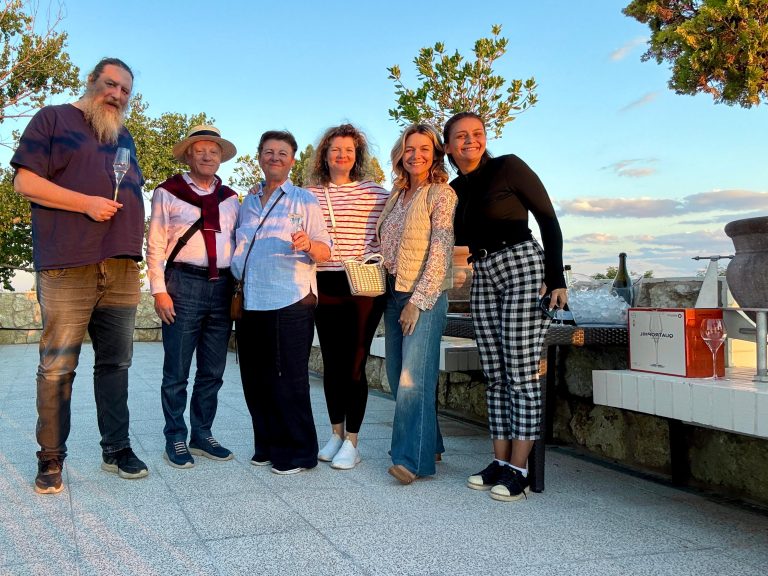
Beauty hides in the details
I hadn’t seen Avincis Winery since its inauguration, when I was more shocked by the scale of the project than seduced by its beauty. Back then, in 2011 or 2012, it seemed like a construction from another world, considering that most producers either renovated old wineries or built simple “sandwich-panel” structures. Here, everything was built from scratch, on the hilltop plateau, with the help of a visionary architect, Alexandru Beldiman, who later received a prestigious award for designing the Vila Dobrușa Estate – not only the winery, but also its surroundings.
This time I had more time to notice the details I had missed during a group trip to the wineries of Drăgășani. The limestone cladding of the winery (which took two years to cut up after being extracted from the quarry), echoed in makeshift towers and oases across the estate. The green strips marking the terrace of the winery, reproducing the geometry of the vineyard’s grassy slopes.
The guest rooms above the winery, elegant, discreetly luxurious, perfectly integrated. The billions of stars in the night sky, never visible in big cities, a sunset and sunrise that leave you speechless – all surrounded by Crâmpoșie and Pinot Noir bubbles, wrapped in the warm words of two lively grandparents, full of incredible energy, who would do anything to delight their guests.
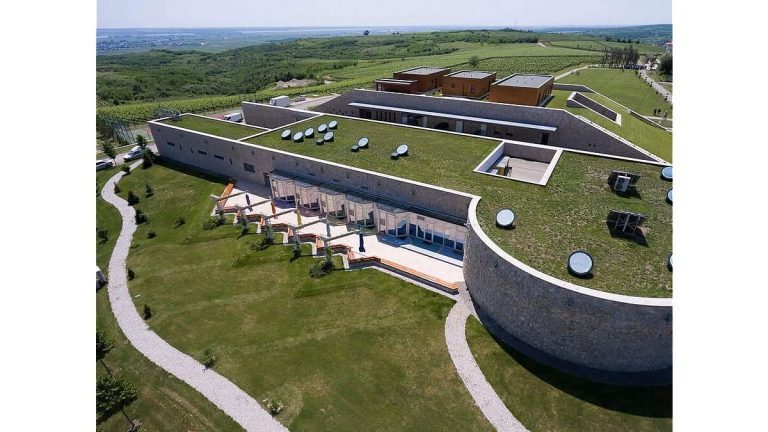
A much better year
The Dobrușa Estate officially has its address on Valea Caselor (The Houses’ Valley) Street. The village, the commune, no longer exist – they have been administratively absorbed into the town of Drăgășani after recent reorganizations, making this estate a rarity: an urban vineyard. Valea Caselor itself is a narrow strip of asphalt, barely wide enough for two small cars to pass each other, winding past villagers’ homes’ front doors and all the way up the hill, to the winery. At the entrance to the estate still stands the last street lantern…
There is also another Valea Caselor, crossed by the highway between Sibiu and Sebeș. Ironically, there you won’t see a single house there, just another irony as passing through a valley nearby called “Valea fără nume” (The Nameless Valley).
Back to Avincis – the harvest has begun and looks promising. Grapes have already been picked for sparkling wine and for the rosé Cuvée Alexis. The vines have recovered after last year’s devastating drought; not a single vine was lost. And this year, without the need for cutting grapes before ripening (to maintain quality), the harvest is close to normal.
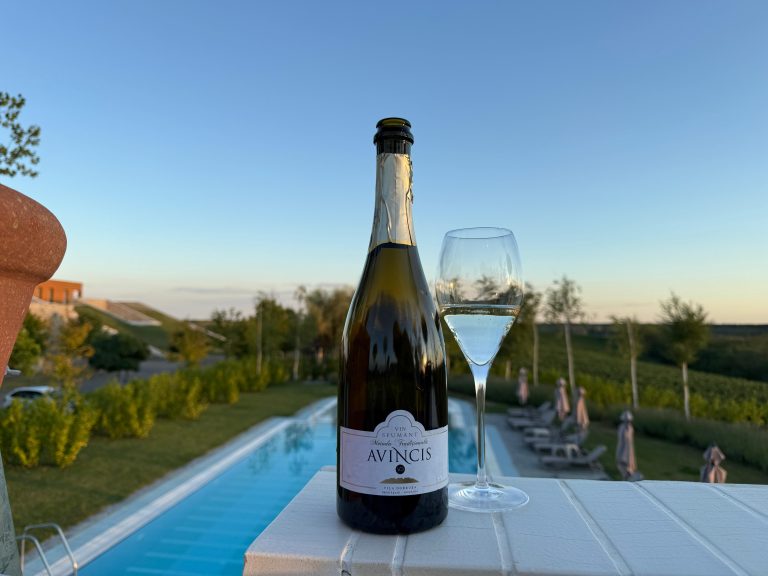
Cristiana Stoica on the place she belongs to
I’ll let Cristiana Stoica introduce the place to you, the place she returned to after a long absence.
“Drăgășani is, I would say, a center of the Romanian oenological universe. It’s not a very large vineyard region – perhaps that’s part of its charm – but it has a very old tradition in winemaking, and just as important, in research. Here, at the Research Station (SCDVV Drăgășani), important grape varieties were born – Crâmpoșia Selecționată, Negru de Drăgășani, Novac, Alutus…
Historically, the vineyards belonged to families who knew what to make of the grapes. Winemakers were also brought in from abroad during the interwar period – we never lacked professionals here. And there was also a strong local intellectual community, which mattered, because they knew what to ask for and how to achieve it.
Great people lived here – like writer Gib Mihăiescu, who also had vineyards and left his mark on this world. Professors, doctors, economists, people from Bucharest who had estates here, who used to gather in the summers in the area. Unfortunately, many of their houses have disappeared, destroyed.
We were lucky, our manor was a bit more isolated. But those who had houses closer to town, including some of my relatives… those houses no longer exist. The heritage was not valued after the vineyards and houses were confiscated, much of the patrimony was lost, just like the local grape varieties: Gordan, Braghină, Negru Vârtos… there were so many…
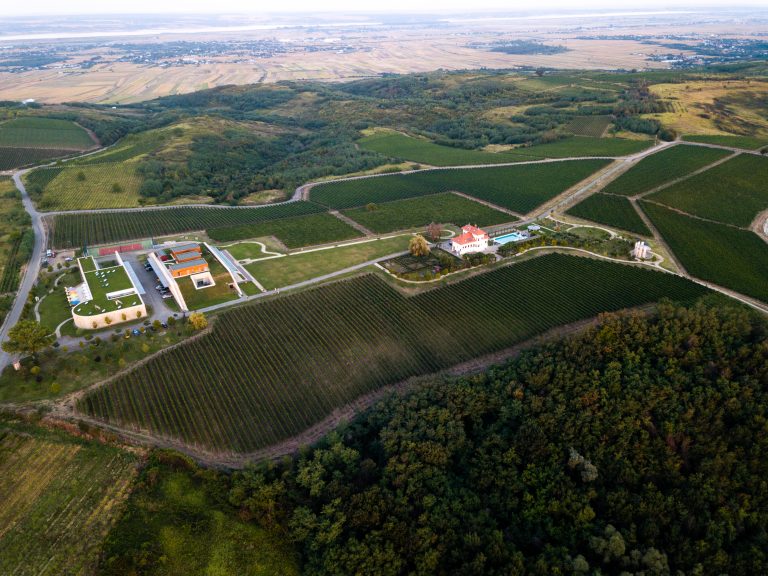
The Local Variety and the New Vineyard
“The local wine used to be made of Gordan, Braghină, Crâmpoșie, and Tămâioasă, following a recipe known by everyone, with all the grapes mixed together. Crâmpoșie was also used as the base wine for a Champagne-style sparkling. Winemakers were brought in from France to teach these techniques; I believe Știrbey produced bottled sparkling wine from Crâmpoșie. Our wine was usually sold in barrels, to tavern-keepers and wine depot owners – back then, wine was mostly consumed by the carafe.”
And again from Cristiana Stoica we learn some specific aspects of what makes Avincis wines special, before moving to the more “sentimental” part of the discussion:
“The terroir is highly diversified – there are big differences between morning and evening, between two consecutive days, the only constants being the light and the breeze. We have plateau areas, gentle slopes, and steeper slopes that form an amphitheater, each bringing its own expression to the grapes.
And we have a great advantage – all the grapes grow around the winery, the farthest parcel being just one kilometer away, which gives us a huge advantage in preserving the freshness of the aromas. And the people here have known how to work the vineyards for centuries, for countless generations, so we’ve never had problems finding workers, whether for harvest or other vineyard work. And I’m glad to see many young people continuing the tradition.”
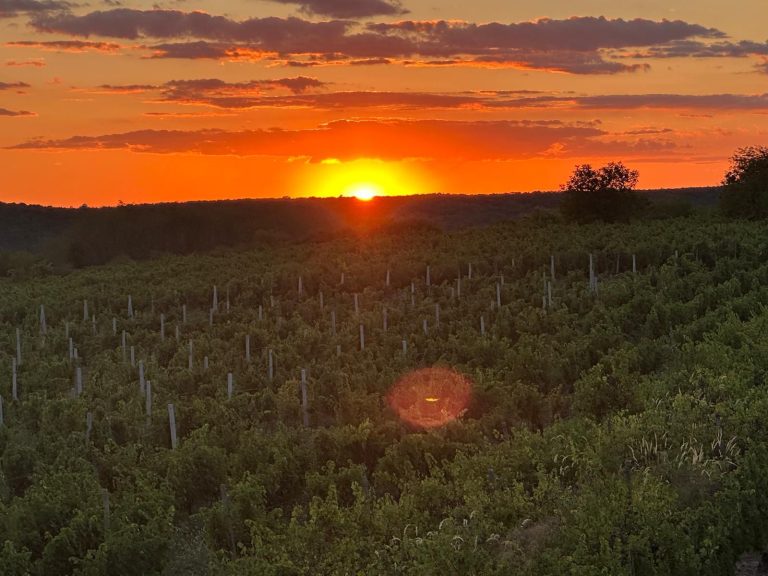
About Those Who Came Before
“If it hadn’t been for communism, we would have grown much further, especially since in 1927 the laws changed and ownership was encouraged. In Romania, there weren’t many large estates – most families had just a few hectares. We were somewhat lucky, because my great-grandfather bought this entire plot in one piece from the former owner, and its charm comes precisely from that unity, which we have preserved. Just as we kept the idea of having vegetable gardens next to the manor…
My great-grandmother lived here from Easter to Christmas, and in those six to seven months she rarely went to town. She went to church for Sunday mass, but her life was here – everything she needed grew around the house. Simple, Romanian food, and a strong spirit – she managed everything by herself, because she was widowed young. Three children and this vineyard… This vineyard kept the place alive and sent all the children to study in Bucharest.
My grandmother was the one who kept us anchored to the family’s past – she came here often, as did my mother, spending all summers and holidays here. Now it’s our turn to do the same.”
The Flavors of the Place
“Back then, people ate charcoal-grilled chicken, meatballs, stuffed peppers – simple, Romanian dishes. Cooking was done on wood stoves; ovens and burners for pans didn’t exist yet…
One of my grandmother’s dishes, something quick to cook between chores, was pea fritters, which I think today would go well with a glass of Fetească Regală. And she also baked excellent pies – she had Aromanian blood and old recipes inspired by that heritage. She made pies with cheese, spinach, apples, whatever she could find.
My great-grandmother, after she had to leave this place, moved to Târgu Jiu and raised me until I was about six. I remember she also made wonderful marinated meatballs. From this hill I don’t have many memories, but I can say something else – back then, taverns were thriving.
People went out, socialized, and would take their guests to Grandiflora or other places in town. If my grandmother needed something, or if she had a large table to prepare, she could arrange with a tavern in town to supply what she needed. But food at home was simple. For more sophisticated dishes, you went to bigger cities, where the ingredients were available.
The first „new taste generation”
My grandmother already cooked differently. She made a roulade with very fluffy dough, lots of eggs, filled with cheese and herbs. She had recipes inspired by French and Austrian cuisine. Puff pastries, wild strawberry mousse tarts, raspberry baskets with Chantilly cream, and many, many others. Turkey aspic (rarely pork), beautifully decorated with herbs, molded in relief-patterned dishes so that when she flipped it onto the plate, it was also a visual spectacle.
Food had to please the eye – otherwise it didn’t pass. She was very demanding of her own work – I saw her cry when a dough didn’t turn out the way she wanted. She would throw it away and start again.
At that time, you learned in school how to cook. At 18, she already knew how to machine-sew, cook, manage a household, and above all things, play the piano – I even took lessons from her when I started learning to play. She had her own sheet music from her youth, worn out but still preserved, and Andreea has now taken over those sheets. Andreea also cooks for her children – tasty dishes, not heavy foods. In our family, we almost never ate heavy foods.
Education transcends time
Cristiana Stoica says that she did not inherit many talents from her grandmother, but when you taste the things created at the winery, you can feel all the education she received. She says that “those were different times, a different kind of education,” yet you can sense the delicacy she inherited in everything she does, and you can even recognize it in the gestures of Andreea, her daughter.
We then talk about the sacrificed generation that lost everything it had built, but left behind a legacy of values that kept the minds of many Romanians awake, even during the dreadful years before 1989. “Because they never lost hope,” says Mrs. Stoica. “The world realized it could not move forward without them, so they survived—with resignation, with dignity and courage. Above all, with dignity.”
Who are you building for?
For people who know and embrace their roots as Cristiana Stoica does, the key question is: what if the heirs did not want what you have built—what would happen then? The answer comes without hesitation: “From the very beginning, we never asked ourselves that question, and I believe that is what helped us move forward. If you think too much about what will happen when you are no longer here, you end up doing nothing. We simply started building, and this is how we came to have this place.
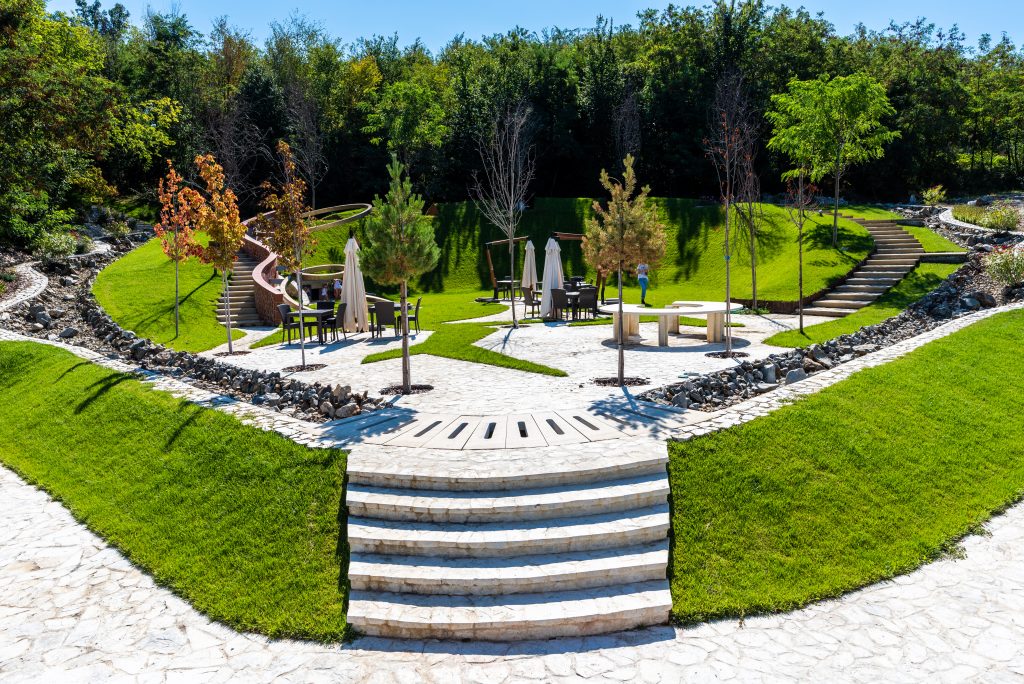
But it became clear quite early on that this place also belongs to Andreea. I felt it from the moment she began coming here and wanted to stay as much as possible. And our grandchildren, her children, absolutely love this place. The problem is that the most beautiful moments in the vineyard overlap with the busiest days of school, at the beginning and end of the year. But they still come, they run through the vines, and the little one—when he was about six years old—couldn’t imagine not climbing onto the tractor; he would cry if he didn’t manage to get up. Now… we can only hope that one day he will get to drive it himself, at least as a hobby.
We are confident that things will be carried on. I believe this is what my grandmother and grandfather would have wanted, because they suffered deeply when they no longer had the vineyard. Her life had become a calendar of vineyard work—this month was for pruning, that month for green work, then came the Crâmpoșie harvest, followed by the Pinot harvest… That was how she measured time, through the vineyard’s calendar, so deeply was she connected to this place. And she passed away with the sorrow of never being able to see it again, after having lived here for 25 years. She was forbidden to return. It is something a bit harder for today’s generations to understand,” says Cristiana Stoica.
About Working in the Family
Law and legislation are closely tied to life at the winery. More than 20 branches of law intersect with viticultural activity. So, in a way, the family members’ profession prepared them well for the life of a winegrower. And what is the secret to living together in harmony, when you cannot fire your life partner or your own child?
Each one takes care of their own area of work, while all major decisions are made together. Andreea handles intellectual property matters, as well as much of the work related to image, communication, and promotion.
Cristiana Stoica focuses mainly on hospitality, pairings, menus, organizing events or cultural evenings, but she also helps with distribution and sales contracts, as well as labor relations. Valeriu Stoica oversees the processes in the vineyard and the winery, from DOC certifications to setting, together with the oenologist, the directions for each vintage’s wines.
Unlike employees and employers, members of the same family are bound by the common desire to make things work smoothly and harmoniously. Negotiations take place differently, and disagreements pass differently as well…
I believe that society should be organized starting from the model of family businesses. Even large enterprises began as family businesses and are grafted onto this structure,” says Cristiana Stoica.
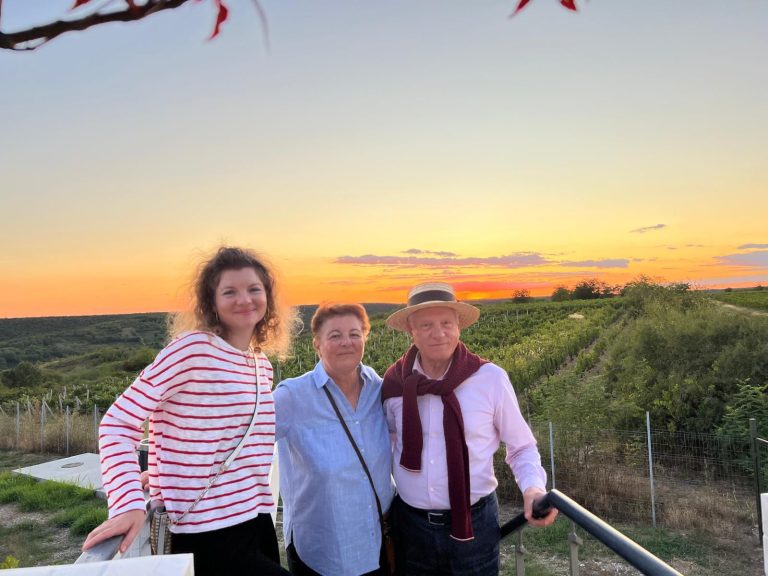
Why do all the paragraphs above seem so chaotic?
At this point, it’s no longer Cristiana Stoica answering, but the author of this article. From the very first paragraph I told you what I wanted to discover and convey from Avincis Winery.
Architecture, sun and stars, harvest reports, interwar intellectuals, grapes lost and grapes newly born, grilled chicken, education, piano, building without worrying about heirs, dividing family responsibilities… What are all these things doing, side by side, like a cosmic shawarma stuffed with a bit of everything?
You never have just one thought, one problem, one goal. Life, harvest, wine – they are never just moments, grapes, bottles. Whether a peasant or a minister, the vintner always keeps one eye on the rain and the other on the latest laws, one hand on the pruning shears and the other on the pump of Bordeaux juice. Whether a scientist like Pasteur or a bon vivant like Păstorel (Romanian prcursor to wine and food journalism), each of us discovers an entire universe in every glass of wine.
Even if I hadn’t visited the winery for more than a decade, I had still had the pleasure of interacting with the Stoicas in Bucharest or at wine fairs and festivals. And I knew that they valued tradition, the legacy they had received, and family. Somehow, I wanted to draw out from them those words that could convey to others how important it is not to give up the past, but to embrace it – whatever it may be – so that you have the strength to build while thinking about those who served as your examples in life.
Not for those who come after you – your role is to become their example, to pass on not just the physical construction, but the values that define a person and their life. Because there are so many who have forgotten, who get confused, who let themselves be deceived, who regret a dark period, or get distracted by glittering bling…
The Conclusion?
When you go to Avincis and you take the time to look closely at the place, then taste the cheese and spinach pie laid on the table at lunch, alongside a glass of sparkling Crâmpoșie, you first need to know in order to later understand.
You need to know that interwar intellectuals brought winemakers from France to plant the tradition (revived today) of Crâmpoșie sparkling wines. Know that a woman was uprooted from exactly the spot where you now stand, one who saw everything her family had ever built taken away, one who once cried when her dough wasn’t as fine as she wanted – probably the same kind of dough you’re tasting now. And one who, on another day, played the piano, as later did her daughter, and later still her granddaughter, on the very same weathered sheets.
You just need to understand a little about that land and the reasons why it ties people to it. Because that is what wine is. And this is only a small bit of what you find in every glass of wine. I only hope I’ve whetted your appetite to discover more.
Photo sources: AVINCIS & Wines of Romania

